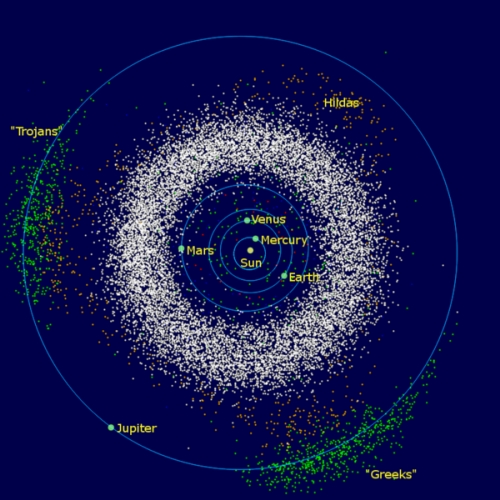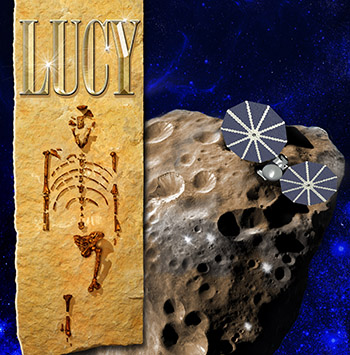Back in 2011, a four planet system called Kepler-223 made a bit of a splash. Researchers led by Jack Lissauer (NASA Ames) at first believed they were looking at two planets that shared the same orbit around their star, each circling the primary in 9.8 days. These co-orbital planets were believed to be in resonance with the other two planets in the system. If the finding were confirmed, it would indicate that one planet had found a stable orbit in a Lagrange point — the L4 and L5 Lagrange points lie 60° ahead and behind an orbiting body. We call an object sharing an orbit like this a trojan, as shown in the figure below, which depicts the best known trojans in our system, the asteroids associated with Jupiter.

Image: Jupiter’s extensive trojan asteroids, divided into ‘Trojans’ and ‘Greeks’ in a nod to Homer, but all trojans nonetheless. Credit: “InnerSolarSystem-en” by Mdf at English Wikipedia – Transferred from en.wikipedia to Commons. Licensed under Public Domain via Commons.
By sheer coincidence I have been reading Peter Green’s splendid new translation of The Iliad (University of California, 2015), so I pause for a moment on the classical theme in naming conventions for Jupiter’s trojans. The German astronomer Max Wolf was the first to spot one of Jupiter’s trojans in 1906, naming it 588 Achilles. Their number quickly swelled, and we now have over 6000 identified Jovian trojans, with a total population of objects over one kilometer in diameter believed to be about one million. The trojan 617 Patroclus, another Homeric reference, was found in 2006 to be composed of water ice, making the Jupiter trojans interesting sources of volatiles.
The work on Kepler-223 was the first time we thought we had found something as large as a trojan planet, but Lissauer and team soon realized that a different interpretation of the light curve was more likely, one in which one of the two co-orbital possibilities had an orbital period that was twice the original estimate. Too bad, because this was quite a fascinating find. There has been speculation that the Earth itself may have once had a small planet at one of its Lagrange points, the ‘Theia’ impactor whose collision with our planet would have produced the Moon.
We now know that trojans can appear at many places in our Solar System, with seven under study at Mars, nine at Neptune, and 2010 TK7 confirmed as the first known Earth trojan in 2011. But Jupiter’s population remains the most robust, and given the composition of 617 Patroclus, it’s good to see that a mission design to explore the Jupiter trojans is emerging. One of five investigations recently chosen by NASA for further study, the project, called Lucy, comes out of the Southwest Research Institute, with Harold Levison as principal investigator.
“This is a once-in-a-lifetime opportunity,” Levison said of the proposed 11-year mission. “Because the Trojan asteroids are remnants of that primordial material, they hold vital clues to deciphering the history of the solar system. These asteroids are in an area that really is the last population of objects in the solar system to be visited.”

$3 million will go into the concept design studies and analysis involved in developing a mission that would study five of the Jupiter trojans, with a launch some time in 2021. The final trojan encounter would occur in 2032. This SwRI news release discusses a spacecraft package containing remote-sensing instruments to study the physical properties of trojans, with three imaging and mapping instruments including a color imaging and infrared mapping spectrometer, a high-resolution visible imager, and a thermal infrared spectrometer. The name ‘Lucy’ is a reference to the fossil remains of an early hominid dating back over three million years.
Image: Lucy, an SwRI mission proposal to study primitive asteroids orbiting near Jupiter, is one of five science investigations under the NASA Discovery Program up for possible funding. Credit: SwRI.
From the standpoint of naming conventions, we haven’t quite finished with the Jovian trojans, though. It turns out that before the idea of naming these objects after Homeric references had fully stabilized, with ‘Trojans’ on one side (L5 in relation to Jupiter) and ‘Greeks’ on the other (L4), both 617 Patroclus and the even more martial 624 Hektor were assigned positions in the wrong camps. Not a recipe for tranquility for any classicist — it was Hector who finished off Patroclus, an event that led to the return of Achilles to battle and a sea-change in the fortunes of the war around Troy.



Here is a nice video clip of the asteroids affected by Jupiter, Jupiter has a huge sway in the solar system.
http://star.arm.ac.uk/neos/JupiterResonance/indexflash.html
Thank you Paul for this article. I sure hope Lucy gets funded.
Above Michael posted a link to a vid of Jupiter resonant asteroids. One of the better animations I’ve seen. I’ll repost it:
http://star.arm.ac.uk/neos/JupiterResonance/indexflash.html
The first part of the animation shows the Hildas with 3:2 resonance.
The Hildas are natural cyclers between the Trojans and Main Belt. Each 2nd aphelion, a Hilda passes through the SJL4 population. Each 3rd aphelion it passes through the SJL5 population. And each perihelion passes through the main belt.
Not only can the Hildas be ferries between the Main Belt and Trojans, but also between SJL4 and SJL5. Caravans enabling trade between the Greeks and Trojans.
Being further from the sun than the main belt asteroids, I’d expect Trojans to be rich with ice. I’m betting lots of H20, CO2, NH3 as well as other valuable volatiles.
Jupiter’s trojans are comparable in resources to that of the asteroid belt.
Clearly from the video we can see that there are orbits within the Lagrange-Euler points that could be natural place for colonies which can use the rich resources there as well as orbits into the main asteroid belt. If you follow some of the asteroids you can see a great number of strange orbits that appear counter intuitive. Now you can also see why no large planet formed in the belt due to the disruption by Jupiter. And as you say Hop there are a lot of volatiles there that would be very useful to space colonies.
sorry if a repost,
I blog here about Professor Okutso research on a Cassini end of mission plan that involved sending the spacecraft on Titan flybys to a Saturn escape orbit back to Jupiter
http://yellowdragonblog.com/2015/08/25/a-multiple-planet-armsep-derived-mission-design-architecture/
You could plan a mission like this Proffer Okusto states and thats what I am thinking you could have a enceladus flyby mission with a Titan escape back to a Trojan!